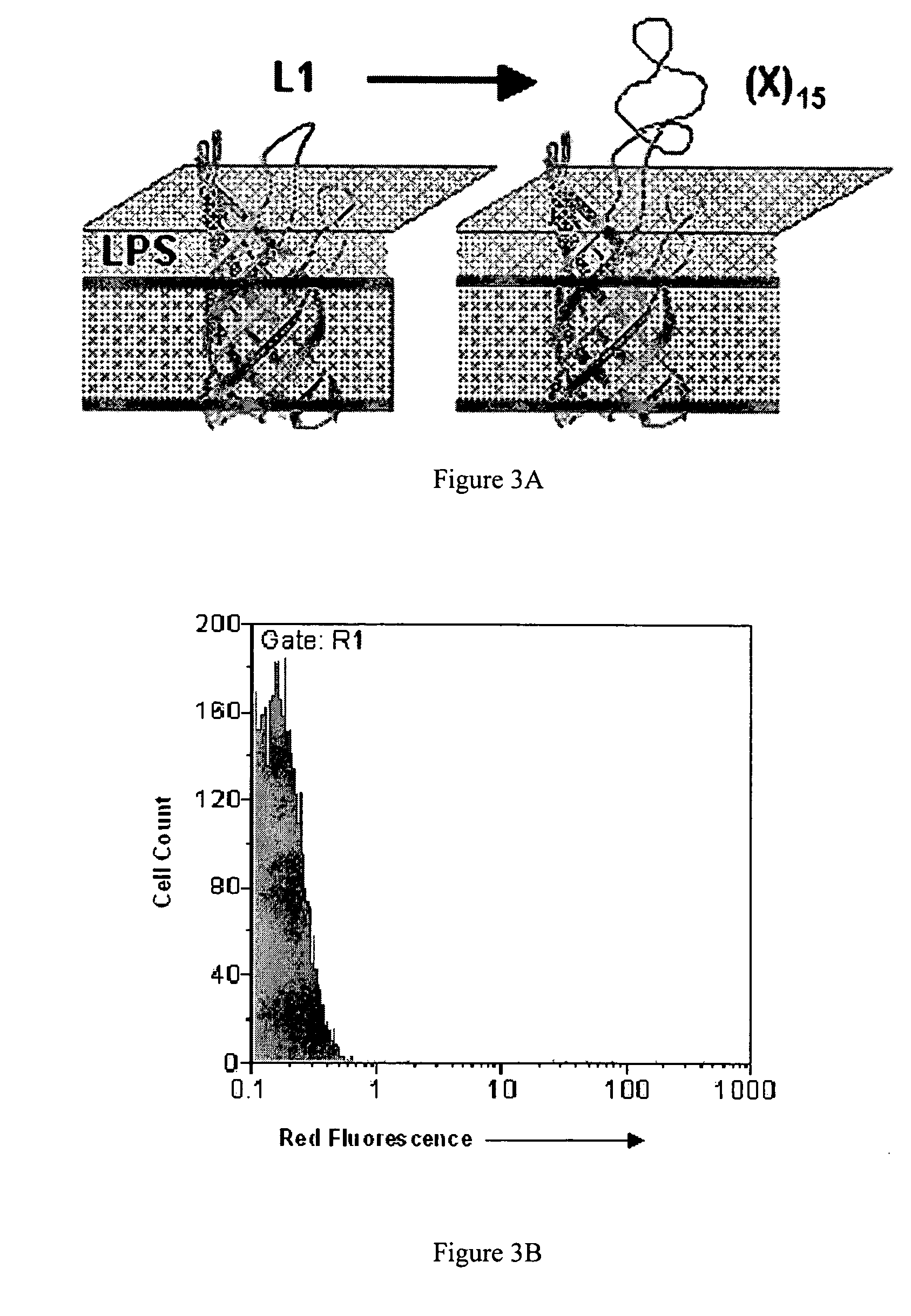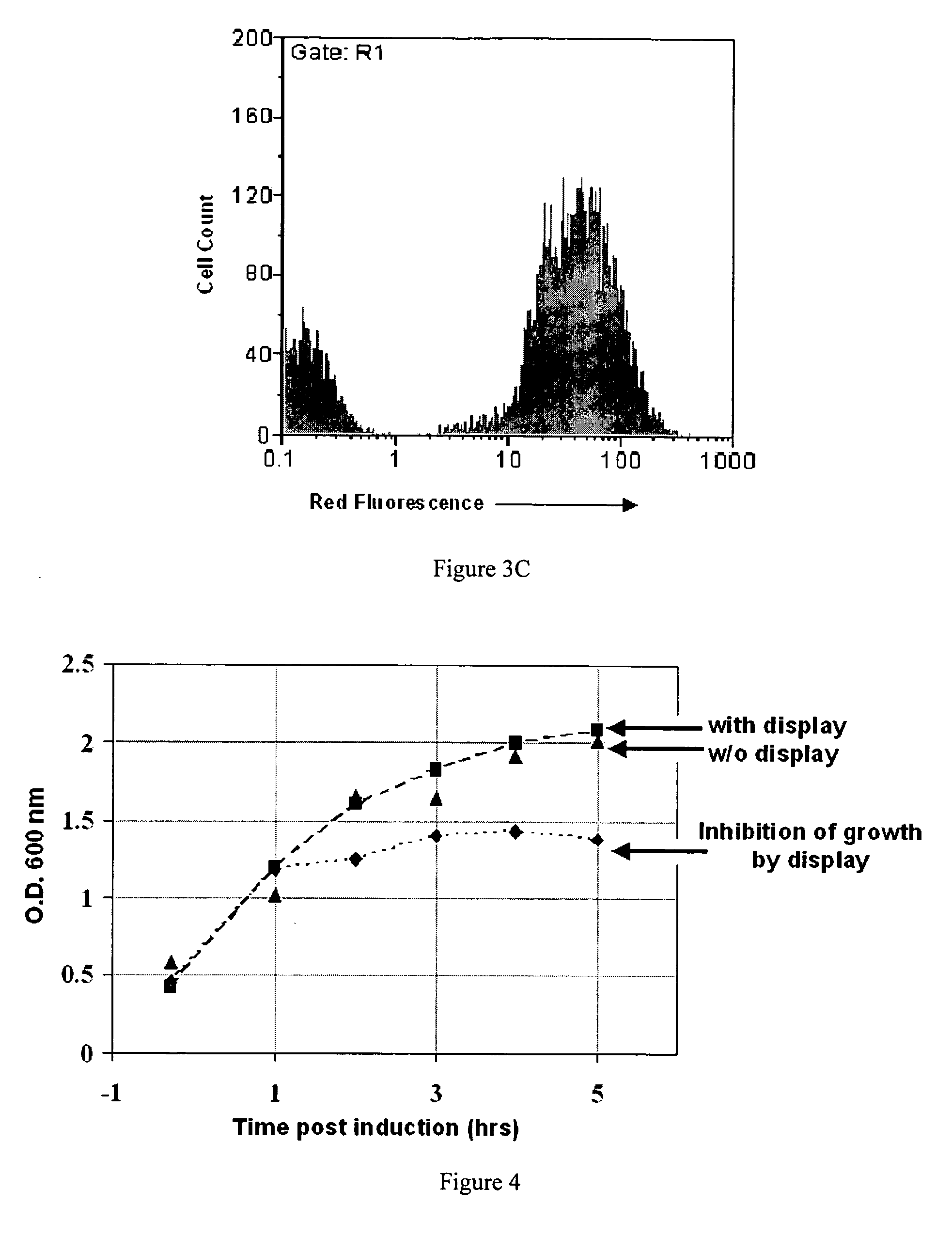Polypeptide display libraries and methods of making and using thereof
a polypeptide and display library technology, applied in the field of bacteria polypeptide display libraries, can solve the problems of clonal loss, phage display presents a few undesirable properties, and overall low quality results
- Summary
- Abstract
- Description
- Claims
- Application Information
AI Technical Summary
Benefits of technology
Problems solved by technology
Method used
Image
Examples
example 1
OmpA Loop 1 Expression Vector
[0182] A 15-mer random insert sequence which provides a balance between sequence complexity and maintenance of the stability and folding and export of OmpA was selected. See FIG. 2. It should be noted that longer length insert, e.g., 15 mer, libraries provide more copies of short sequences while allowing for possible longer cell binding motifs requiring 10 or more amino acids. Although an engineered disulphide bridge may be used for stabilization, such was not used as cystein oxidation in the E. coli periplasm could lead to aggregation and reduced export and disulfides could potentially emerge by chance. Moreover, the membrane spanning domain of OmpA already provides a rigid structural anchor for the peptide inserts into the more flexible loops.
[0183] After optimizing the library construction process through the use of the pBAB33L1, construction of a high quality library of about 4.5×1010 independent transformants was found to be possible. This library...
example 2
OmpX Loop 2 and OmpX Loop 3 Expression Vectors
[0214] While the following protocol specifically describes the construction of vectors for the display of polypeptides and polypeptide libraries in loop 2 of OmpX, this procedure may be readily applied to loop 3 of OmpX, by consideration of the non-conserved regions in loop 3 as described in Table 3, by one skilled in the art. In loop 3, peptide insertions are preferred between residues 94-99, and preferably between residues 95-97, with Pro96 removed. The wild-type OmpX gene from E. coli MC1061:
atgaaaaaaattgcatgtctttcagcactggccgcagttctggctttcaccgcaggtacttccgta(SEQ ID NO:102)gctgcgacttctactgtaactggcggttacgcacagagcgacgctcagggccaaatgaacaaaatgggcggtttcaacctgaaataccgctatgaagaagacaacagcccgctgggtgtgatcggttctttcacttacaccgagaaaagccgtactgcaagc / tctggtgactacaacaaaaaccagtactacggcatcactgctggtccggcttaccgcattaacgactgggcaagcatctacggtgtagtgggtgtgggttatggtaaattccagaccactgaatac / ccg / acctacaaacacgacaccagcgactacggtttctcctacggtgcgggtctgcagttcaacccgatggaaaacg...
example 3
Circularly Permuted OmpX (CPX)
[0217] Display and expression of passenger polypeptides as N or C terminal fusions is accomplished by topological permutation of an Omp as shown in FIG. 14. Sequence rearrangement of an outer membrane protein, in this case OmpX, was accomplished using an overlap extension PCR methods known in the art in order to create either N or C terminal fusion constructs. See Ho, et al. (1989) Gene 77(1):51-59, which is herein incorporated by reference; and see FIG. 14, FIG. 27, FIG. 28, FIG. 30, and FIG. 32. Polypeptide passenger insertion points are chosen to occur within non-conserved, surface exposed loop sequences of surface exposed proteins, such as monomeric Omps (including OmpA, OmpX, OmpT, and the like) using methods known in the art.
[0218] The DNA sequence of the N / C terminal fusion expression vector provides the following contiguous components fused or linked in linear order from N to C terminus (See FIG. 14): [0219] 1. A DNA sequence encoding an N-ter...
PUM
| Property | Measurement | Unit |
|---|---|---|
| time | aaaaa | aaaaa |
| concentrations | aaaaa | aaaaa |
| volume | aaaaa | aaaaa |
Abstract
Description
Claims
Application Information
 Login to View More
Login to View More - R&D
- Intellectual Property
- Life Sciences
- Materials
- Tech Scout
- Unparalleled Data Quality
- Higher Quality Content
- 60% Fewer Hallucinations
Browse by: Latest US Patents, China's latest patents, Technical Efficacy Thesaurus, Application Domain, Technology Topic, Popular Technical Reports.
© 2025 PatSnap. All rights reserved.Legal|Privacy policy|Modern Slavery Act Transparency Statement|Sitemap|About US| Contact US: help@patsnap.com



